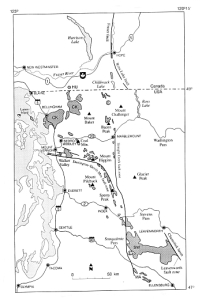Here is a field guide to cool places in the Chuckanut Formation. I will add new places to visit over time, and really welcome your contributions. Please include good photos, with something for scale. Photos need to be around 700-800 pixels in the large dimension, at 72 dpi.
Field trips are:
A walking traverse through layers in the Chuckanut (added June 26, 2020)
Rock Trail (added April 11, 2014)
Raptor Ridge (added 11/23/2011)
Teddy Bear Cove conglomerate on Chuckanut Bay.
The fossil fields of the Racehorse Creek landslide, near Kendall in the North Fork Nooksack.
The geology of Squires Lake and Alger Alp.
Alternating thin beds of sandstone and conglomerate at West Point, Lummi Island.
A large slab of glacially striated sandstone off San Juan Blvd, east edge of Bellingham. GONE
A flood-scoured gorge at Silver Creek, near the north end of Lake Samish. Great sedimentary structures, and a lovely high waterfall.
Bedrock geology of downtown Bellingham:1) A small syncline on the south edge of downtown Bellingham COVERED BY CONSTRUCTION; 2) the outcrop behind the Mount Baker Theater (Theatre).
A layer of tuff (volcanic ash) at Clayton Beach, along Chuckanut Drive; reveals a volcanic eruption 50 million years ago.
The January 2009 deep-seated Racehorse Creek landslide; the largest of the many in the region.
Honey comb weathering (tafoni); beautiful weathering structures along the Chuckanut coast.
Landslides along Chuckanut Drive (WA State Route 11) and how they are repaired.

Outcrop map of Chuckanut Formation (CK), courtesy of George Mustoe, WWU. The large unit in the lower right is the correlative Swauk Formation (SK). Click to enlarge.
The Eocene Chuckanut Formation consists of a phenomenally thick sequence (9000 m!) of alluvial sandstone, conglomerate, mudstone, and coal, originally deposited in flood plains in subsiding basins near the coast of Washington- or at least, where the coast was around 50,000,000 years ago. Sediment sources were the highlands of the Rocky Mountains and the southern interior of British Columbia. Deposition was prior to growth of the Cascade arc or subduction-accretion of the Crescent Terrane (broadly, the Olympic Peninsula rocks). Orogeny of the Cascade Range effectively shut off the sediment supply. Docking of the Crescent Terrane deformed the Chuckanut sedimentary rocks. Most people know that Chuckanut rocks are found in west-central Whatcom County. However, scattered units of these rocks also extend along the Darrington-Devil’s Mountain fault zone through Skagit and Snohomish Counties. Visits to sites in these less well-known localities will be included here as well. A succinct introduction to the Chuckanut is “Geology and paleontology of the early Tertiary Chuckanut Formation” by G. Mustoe, R. Dilhoff, and T. Dillhoff, 2007. This appears in the 2007 Cordilleran GSA Field Guide, Floods, Faults, and Fire: Geological Field Trips in Washington State and Southwest British Columbia.



I just wanted to say…this is an amazing blog! It is very informative and well documented. I am the Science Outreach Coordinator for the Northwest Indian College and I will be taking approx. 20 high school youth over to Larrabee to study the amazing geology found there on May 14th. I would love to touch base with you or folks you may know who may be able to help point me in the right direction with accessable and interesting geology formations. Thanks for the good read and I look forward to hearing from you soon.
Nathanael Davis
Northwest Indian College
[…] I live in the land of lumps: Blanchard, Chuckanut, Stewart, Anderson, Lyman, Sumas, etc. Dave Tucker has some great information about them on his site, Northwest Geology Fieldtrips. […]
[…] can learn more about the geology of the area on the excellent website, Northwest Geology Field Trips.] We could see rain showers coming across the water, and we got the first misty drops of the […]
[…] (or is it?) lines the road.(For field trips to real exposures and features in the Chuckanut, go here on this […]